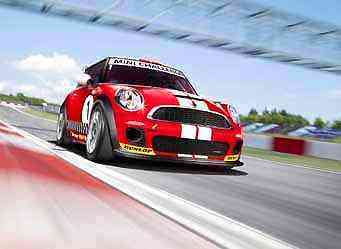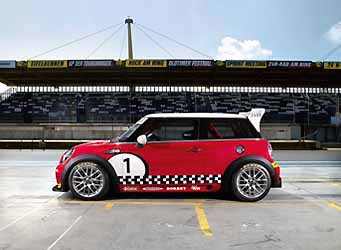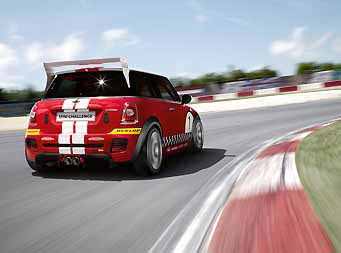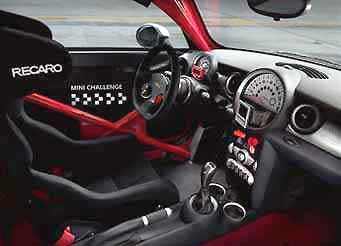
A further
incentive, of course, is prize money in the MINI CHALLENGE Germany 2007 alone
of Euro 340,000, plus three MINIs as special prizes er

Im Preisgeldtopf der MINI CHALLENGE Deutschland
2007 befinden sich insgesamt 340 000 Euro. Zusätzlich sind als Sachpreise
drei MINI zu gewinnen
ZUR DEUTSCHEN VERSION |
Warm-up at the 2007 Frankfurt Motor Show: The
MINI John Cooper Works CHALLENGE
The new MINI
has already impressively proven its sporting talent on the road. And soon
the racing version of this new generation of the world's only small premium
car, the new MINI John Cooper Works CHALLENGE, will be ready to
go:
 Parallel to the ongoing MINI CHALLENGE
2007, development specialists are already working on the racing car for the
next season in this unique Clubsport Series. It is indeed already clear today
that the new model based on the new MINI Cooper S will be an even more thrilling
racing machine offering participants in the MINI CHALLENGE 2008 an even more
intense driving experience. Even before its first start, the MINI John Cooper
Works CHALLENGE stands out through a wide range of new records and benchmarks
in terms of maximum torque, the power-to-weight ratio, acceleration, and
top speed. Drivers are also able to look forward to lateral acceleration,
traction and stopping power never seen before, the new racing car setting
new standards not "only" in terms of agility, but also in terms of safety.
For spectators watching the races for the MINI CHALLENGE 2008 this means
even greater excitement, even faster action and even more struggles for
leadership on the track. The MINI John Cooper Works CHALLENGE is making its
debut at the 2007 Frankfurt Motor Show where the public will be able to get
their first impression of the new racing car scheduled for delivery to the
participating teams in spring 2008, that is in good time prior to the beginning
of the MINI CHALLENGE 2008. This will also be the first time that the car
raced in the MINI CHALLENGE will be pitched against racing cars made by other
manufacturers as a further new challenge in 2008, since the new MINI John
Cooper Works CHALLENGE will also be delivered in race trim including all
features required for superior performance and safety to customers entering
other motorsport events outside the MINI CHALLENGE itself. This is simply
because, thanks to its outstanding performance and superior handling, the
new MINI offers everything it takes in motorsport in order to compete
successfully against other brands too. Parallel to the ongoing MINI CHALLENGE
2007, development specialists are already working on the racing car for the
next season in this unique Clubsport Series. It is indeed already clear today
that the new model based on the new MINI Cooper S will be an even more thrilling
racing machine offering participants in the MINI CHALLENGE 2008 an even more
intense driving experience. Even before its first start, the MINI John Cooper
Works CHALLENGE stands out through a wide range of new records and benchmarks
in terms of maximum torque, the power-to-weight ratio, acceleration, and
top speed. Drivers are also able to look forward to lateral acceleration,
traction and stopping power never seen before, the new racing car setting
new standards not "only" in terms of agility, but also in terms of safety.
For spectators watching the races for the MINI CHALLENGE 2008 this means
even greater excitement, even faster action and even more struggles for
leadership on the track. The MINI John Cooper Works CHALLENGE is making its
debut at the 2007 Frankfurt Motor Show where the public will be able to get
their first impression of the new racing car scheduled for delivery to the
participating teams in spring 2008, that is in good time prior to the beginning
of the MINI CHALLENGE 2008. This will also be the first time that the car
raced in the MINI CHALLENGE will be pitched against racing cars made by other
manufacturers as a further new challenge in 2008, since the new MINI John
Cooper Works CHALLENGE will also be delivered in race trim including all
features required for superior performance and safety to customers entering
other motorsport events outside the MINI CHALLENGE itself. This is simply
because, thanks to its outstanding performance and superior handling, the
new MINI offers everything it takes in motorsport in order to compete
successfully against other brands too. |
The perfect foundation: four-cylinder
power unit with twin-scroll turbocharger.
 The power machine within the engine
compartment of the MINI John Cooper Works CHALLENGE is the four-cylinder
already demonstrating its sporting spirit in the regular version of the MINI
Cooper S. As the most powerful representative of the new MINI generation,
this outstanding machine offers pure fun of driving, the power of a brand-new
engine, and that go-kart feeling already legendary in the market, making
this a genuine exception in the small car segment.This 1.6-litre four-cylinder
features a twin-scroll turbocharger and direct gasoline injection, developing
maximum output of 128 kW/175 hp at 5,500 rpm. Output per litre, therefore,
is 80.1 kW or 109.5 hp - a figure which places the new MINI Cooper S very
close to the most thoroughbred sports cars. Maximum torque of 240 Newton-metres
or 177 lb-ft, on the other hand, is maintained consistently between 1,600
and 5,000 rpm. And whenever the driver wishes to accelerate all-out, the
Overboost function briefly increases turbocharger pressure to a maximum of
260 Nm or 192 lb-ft. The outstanding strengths of the power unit in this
compact performer, therefore, are spontaneous power, muscular torque and
acceleration, as well as smooth, free-running engine behaviour. The qualities
of the new turbocharged engine come out clearly in everyday traffic and indeed
were confirmed only recently by an international jury of experts lauding
the engine in the new MINI Cooper S through the Engine of the Year Award
2007 as the winner in its category. The 16 intake and outlet valves on the
engine are masterminded by two overhead camshafts, roller-type drag arms
optimised for minimum friction and hydraulic valve play compensation elements.
The outlet valves are filled with sodium to meet the particularly demanding
requirements of a turbocharged power unit, the intake camshaft comes with
infinite phase adjustment setting valve timing to the power and performance
required by the driver. The two-piece bedplate structure of the crankcase
is a highly sophisticated technology carried over from motorsport. The cylinder
block and bearing housing are made of cast aluminium alloy and the camshafts
are a composite structure instead of the usual casting, serving to reduce
engine weight. Contrary to the conventional casting process, cam rings made
of high-strength stainless steel are shrunk on to the shaft as such. The
pistons, finally, running in cast-iron bushes, are cooled by splash oil and
are therefore able to withstand very high temperatures and thermal conditions. The power machine within the engine
compartment of the MINI John Cooper Works CHALLENGE is the four-cylinder
already demonstrating its sporting spirit in the regular version of the MINI
Cooper S. As the most powerful representative of the new MINI generation,
this outstanding machine offers pure fun of driving, the power of a brand-new
engine, and that go-kart feeling already legendary in the market, making
this a genuine exception in the small car segment.This 1.6-litre four-cylinder
features a twin-scroll turbocharger and direct gasoline injection, developing
maximum output of 128 kW/175 hp at 5,500 rpm. Output per litre, therefore,
is 80.1 kW or 109.5 hp - a figure which places the new MINI Cooper S very
close to the most thoroughbred sports cars. Maximum torque of 240 Newton-metres
or 177 lb-ft, on the other hand, is maintained consistently between 1,600
and 5,000 rpm. And whenever the driver wishes to accelerate all-out, the
Overboost function briefly increases turbocharger pressure to a maximum of
260 Nm or 192 lb-ft. The outstanding strengths of the power unit in this
compact performer, therefore, are spontaneous power, muscular torque and
acceleration, as well as smooth, free-running engine behaviour. The qualities
of the new turbocharged engine come out clearly in everyday traffic and indeed
were confirmed only recently by an international jury of experts lauding
the engine in the new MINI Cooper S through the Engine of the Year Award
2007 as the winner in its category. The 16 intake and outlet valves on the
engine are masterminded by two overhead camshafts, roller-type drag arms
optimised for minimum friction and hydraulic valve play compensation elements.
The outlet valves are filled with sodium to meet the particularly demanding
requirements of a turbocharged power unit, the intake camshaft comes with
infinite phase adjustment setting valve timing to the power and performance
required by the driver. The two-piece bedplate structure of the crankcase
is a highly sophisticated technology carried over from motorsport. The cylinder
block and bearing housing are made of cast aluminium alloy and the camshafts
are a composite structure instead of the usual casting, serving to reduce
engine weight. Contrary to the conventional casting process, cam rings made
of high-strength stainless steel are shrunk on to the shaft as such. The
pistons, finally, running in cast-iron bushes, are cooled by splash oil and
are therefore able to withstand very high temperatures and thermal conditions. |
The new MINI Cooper S is the first car in its segment with a power unit featuring
a twin-scroll turbocharger. This principle ensures particularly spontaneous
power and performance at all times, the ducts of two cylinders each coming
together within the exhaust manifold and the turbocharger. This particular
arrangement reduces exhaust gas counter-pressure at low engine speeds, with
the dynamic effect of the pulsating gas columns in the manifold being put
to optimum use and improving the response of the turbocharger accordingly.
Turbocharger pressure is limited by a waste gate to 0.8 bar. Since the
turbocharger develops its superior boost from a speed of just 1,400 rpm,
there is no turbo gap, like on a turbocharged engine with conventional
technology. Direct gasoline injection based on the common-rail principle
ensures a highly efficient supply of fuel in all cases, meeting the driver's
current demand for power and performance. A high-pressure pump fills
the stainless-steel common rail leading to all cylinders with fuel subsequently
injected through the injection valves positioned at the sides of the cylinder
head into the combustion chambers in an exact dosage. Four valve pockets
and the combustion chamber recess in the middle of each piston, finally,
ensure optimum charge stratification of the homogenous fuel/air mixture.
The optimised weight of the power unit made completely of light alloy also
contributes to the sporting qualities of the car - both on the road and the
race track. And the reduced load on the front axle ensures a perfect balance
of weight, providing ideal conditions for supreme agility in tight bends
and chicanes.
Motorsport know-how for more power
and torque.
Using specific and highly appropriate technologies for extra power, the "regular"
engine of the MINI Cooper S is already an outstanding performer and is now
becoming a genuine high-performance power machine for the race track. Indeed,
though its performance alone, the racing version prepared for the MINI CHALLENGE
2008 outperforms the current racing model, even though maximum engine output
of 154 kW/210 hp is exactly the same as in the current MINI CHALLENGE racing
car. The crucial point, therefore, is that the engineers specialising in
the con-struction of racing cars and engines, by optimising the engine's
charac-teristics, increasing torque to an even higher level, and adding an
exhaust system specifically conceived for motorsport, have put all the conditions
in place for even more convincing performance. Maximum torque is up by 20
Newton-metres or almost 15 lb-ft over the regular model, now amounting to
260 Nm or 192 lb-ft, with Overboost increasing the torque peak briefly to
280 Nm or 206 lb-ft for a particularly powerful sprint whenever required.
The enhanced torque and pulling force provided by the new engine comes to
bear right from the start, with the improved elasticity and higher top speed
cutting in briefly thereafter. So despite engine power remaining unchanged,
new lap records are to expected in the MINI CHALLENGE 2008. Such very fast
lap times will be attributable not just to the new engine, but also to the
reduction of starter weight on the new model down by 30 kilos to 1,150 kg
(including the driver), aerodynamics improved all round on the car, as well
as the high-performance chassis and suspension of the new MINI John Cooper
Works CHALLENGE specially modified for motorsport.
Faster when sprinting, quicker in bends,
earlier at a standstill.
 A well-balanced package of power-enhancing
improvements makes the MINI John Cooper Works CHALLENGE a truly exceptional
sports machine. The new racing car sprints faster than before and offers
better stopping power thanks to its specially developed motorsport brakes
and the anti-lock brake system tailored specifically to racing requirements.
The car is lighter than its predecessor but rests a lot more firmly on the
road, achieving significantly higher speeds in bends and offering even more
superior handling. The new MINI John Cooper Works CHALLENGE accelerates to
100 km/h in just 6.1 seconds and takes only 3.1 seconds to return from the
same speed to a standstill. Top speed of the new racing car is 240 km/h or
149 mph. A further important point is the extremely fast lateral acceleration
offered by the new MINI CHALLENGE racing car. This high speed in bends is
indeed further enhanced by even faster acceleration out of the bend on to
the next straight. To prevent the drive wheels from spinning when leaving
a bend, this is the first car in the MINI CHALLENGE to feature a limited-slip
differential instantaneously conveying a larger share of the engine's power
to the wheel with better traction. The limited-slip differential also available
on the regular production model thus enables the driver to remain on the
ideal line at an even higher speed than before. The suspension on the new
racing model comes with adjustable damper units likewise developed specifically
for motorsport. This enables the driver to adjust ground clearance, damper
pressure (inbound and outbound) as well as damper response to the requirements
of various race tracks. Power is transmitted to the front wheels through
a six-speed manual gearbox featured as standard, and the new racing model
runs on 17-inch light-alloy wheels (Borbet) in special MINI CHALLENGE design
and with newly developed racing tyres (Dunlop). The new MINI John Cooper
Works CHALLENGE owes its unusually superior handling also to the highly effective
improvement of body features. These enhancements are based on the John Cooper
Works Aerodynamics Package, comprising a front spoiler designed specifically
for motorsport, a rear diffuser, and an adjustable rear wing. This combination
of racing features ensures that this racing car not only eliminates lift
forces, but even generates downforces at increasing speed, with the aerodynamic
improvements being conceived to provide a perfect balance of downforces between
the front and rear axles. A well-balanced package of power-enhancing
improvements makes the MINI John Cooper Works CHALLENGE a truly exceptional
sports machine. The new racing car sprints faster than before and offers
better stopping power thanks to its specially developed motorsport brakes
and the anti-lock brake system tailored specifically to racing requirements.
The car is lighter than its predecessor but rests a lot more firmly on the
road, achieving significantly higher speeds in bends and offering even more
superior handling. The new MINI John Cooper Works CHALLENGE accelerates to
100 km/h in just 6.1 seconds and takes only 3.1 seconds to return from the
same speed to a standstill. Top speed of the new racing car is 240 km/h or
149 mph. A further important point is the extremely fast lateral acceleration
offered by the new MINI CHALLENGE racing car. This high speed in bends is
indeed further enhanced by even faster acceleration out of the bend on to
the next straight. To prevent the drive wheels from spinning when leaving
a bend, this is the first car in the MINI CHALLENGE to feature a limited-slip
differential instantaneously conveying a larger share of the engine's power
to the wheel with better traction. The limited-slip differential also available
on the regular production model thus enables the driver to remain on the
ideal line at an even higher speed than before. The suspension on the new
racing model comes with adjustable damper units likewise developed specifically
for motorsport. This enables the driver to adjust ground clearance, damper
pressure (inbound and outbound) as well as damper response to the requirements
of various race tracks. Power is transmitted to the front wheels through
a six-speed manual gearbox featured as standard, and the new racing model
runs on 17-inch light-alloy wheels (Borbet) in special MINI CHALLENGE design
and with newly developed racing tyres (Dunlop). The new MINI John Cooper
Works CHALLENGE owes its unusually superior handling also to the highly effective
improvement of body features. These enhancements are based on the John Cooper
Works Aerodynamics Package, comprising a front spoiler designed specifically
for motorsport, a rear diffuser, and an adjustable rear wing. This combination
of racing features ensures that this racing car not only eliminates lift
forces, but even generates downforces at increasing speed, with the aerodynamic
improvements being conceived to provide a perfect balance of downforces between
the front and rear axles. |
MINI CHALLENGE: the thrill of motorsport
and lifestyle.
The premiere for the new MINI John Cooper Works CHALLENGE is the first step
in continuing a unique story of success. Indeed, the MINI CHALLENGE held
ever since 2004 in its current concept has quickly become one of the most
attractive and popular Clubsport Series, with CHALLENGE races being held
not only in Germany, but also in the Netherlands, in Belgium and in Austria.
Some of these races are even held prior to major Formula 1 events, such as
the European Grand Prix at Nürburgring and the Belgium Grand Prix in
Spa-Francorchamps. Through its great appeal, this Clubsport Series has indeed
developed into not "just" a pan-European, but also a global phenomenon: With
a MINI CHALLENGE Series already being held in New Zealand, the MINI fan thrilled
by motorsport will soon also be able to enjoy these outstanding races in
Australia, where yet another MINI CHALLENGE Series has been announced for
2008. The MINI CHALLENGE owes its exceptional appeal to an innovative concept:
motorsport meets lifestyle - a combination which has proved very successful
and highly popular among both drivers and fans. At the same time the drivers
on the starter grid also contribute to the special atmosphere of the MINI
CHALLENGE, old hands and young, up-and-coming talents in motorsport comparing
their skills with celebrities from show business and other disciplines in
sport.
The sporting symbol of the MINI CHALLENGE:
absolute equality.
An essential point is that all drivers enter the races in technically identical
cars: All MINI CHALLENGE racing cars are built to the same standard and optimised
for the race track in the interest of absolute equality - an essential feature
of the MINI CHALLENGE placing the emphasis on the driver's skills. To ensure
an absolutely perfect balance with equal opportunities, successful drivers
are required to carry extra weight in the subsequent races depending on their
initial result, the winning car, for example, carrying extra ballast in the
next race. And taking the example of the World Touring Car Championship,
the top six drivers in the first race subsequently enter the next race in
a reversed grid. Through its superior handling alone and the wide range of
safety features incorporated in the racing models, the MINI CHALLENGE is
of particular interest to the beginner in motorsport and the ambitious amateur
driver.
 A further incentive, of course, is prize
money in the MINI CHALLENGE Germany 2007 alone of Euro 340,000, plus three
MINIs as special prizes. The introduction of the new racing models for the
MINI CHALLENGE 2008 now enhances the sporting appeal of this innovative Club
Sport Series to an even higher standard: The sporting potential of the new
MINI John Cooper Works CHALLENGE offers the drivers every opportunity to
set up new lap records and thrill the crowd with even fiercer battles on
the track. In future spectators will enjoy even higher speeds together with
greater safety also during pitstops in the qualifying sessions, since each
car is now equipped with an air pressure elevating system made of four
retractable pneumatic hoists on the bottom of the car activated by compressed
air in the pits and lifting up the car as required for changing tyres in
a very quick and dynamic process. At the same time the new racing model also
offers enhanced safety borne out not only by the even better handling of
the new MINI. For like the current racing version, the new MINI John Cooper
Works CHALLENGE is equipped with a safety cage welded firmly to the body
of the car. Over and above the RECARO sports bucket seat combined in future
with a six-point safety belt, all racing models will also come from now on
with the HANS (Head And Neck Support) system carried over from Formula 1
and ensuring effective protection of the driver's neck area. A further incentive, of course, is prize
money in the MINI CHALLENGE Germany 2007 alone of Euro 340,000, plus three
MINIs as special prizes. The introduction of the new racing models for the
MINI CHALLENGE 2008 now enhances the sporting appeal of this innovative Club
Sport Series to an even higher standard: The sporting potential of the new
MINI John Cooper Works CHALLENGE offers the drivers every opportunity to
set up new lap records and thrill the crowd with even fiercer battles on
the track. In future spectators will enjoy even higher speeds together with
greater safety also during pitstops in the qualifying sessions, since each
car is now equipped with an air pressure elevating system made of four
retractable pneumatic hoists on the bottom of the car activated by compressed
air in the pits and lifting up the car as required for changing tyres in
a very quick and dynamic process. At the same time the new racing model also
offers enhanced safety borne out not only by the even better handling of
the new MINI. For like the current racing version, the new MINI John Cooper
Works CHALLENGE is equipped with a safety cage welded firmly to the body
of the car. Over and above the RECARO sports bucket seat combined in future
with a six-point safety belt, all racing models will also come from now on
with the HANS (Head And Neck Support) system carried over from Formula 1
and ensuring effective protection of the driver's neck area. |
More performance, more action, more excitement: Fans of the MINI CHALLENGE
can look forward to a fascinating racing season in 2008. And the sporting
challenge will be even greater for the driver than ever before, with the
MINI John Cooper Works CHALLENGE offering better opportunities to prove the
racer's driving talent in spectacular manoeuvres and with even faster lap
times. So the struggle for the podium will be even more exciting than ever
before in the MINI CHALLENGE 2008, with one winner being clear right from
the start: the MINI John Cooper Works CHALLENGE itself. The cars will also
be entered in many other motorsport events in 2008, the MINI John Cooper
Works CHALLENGE offering the ambitious racing driver an extremely competitive
car for many purposes and requirements.
So it is fair to say that the sporting career of the new MINI is set for
new highlights. (All technical data of the MINI John Cooper Works CHALLENGE
is preliminary.)
READER COMMENTS
| BMW Group, Public Relations,
September 2007 |
BACK TO TOP |